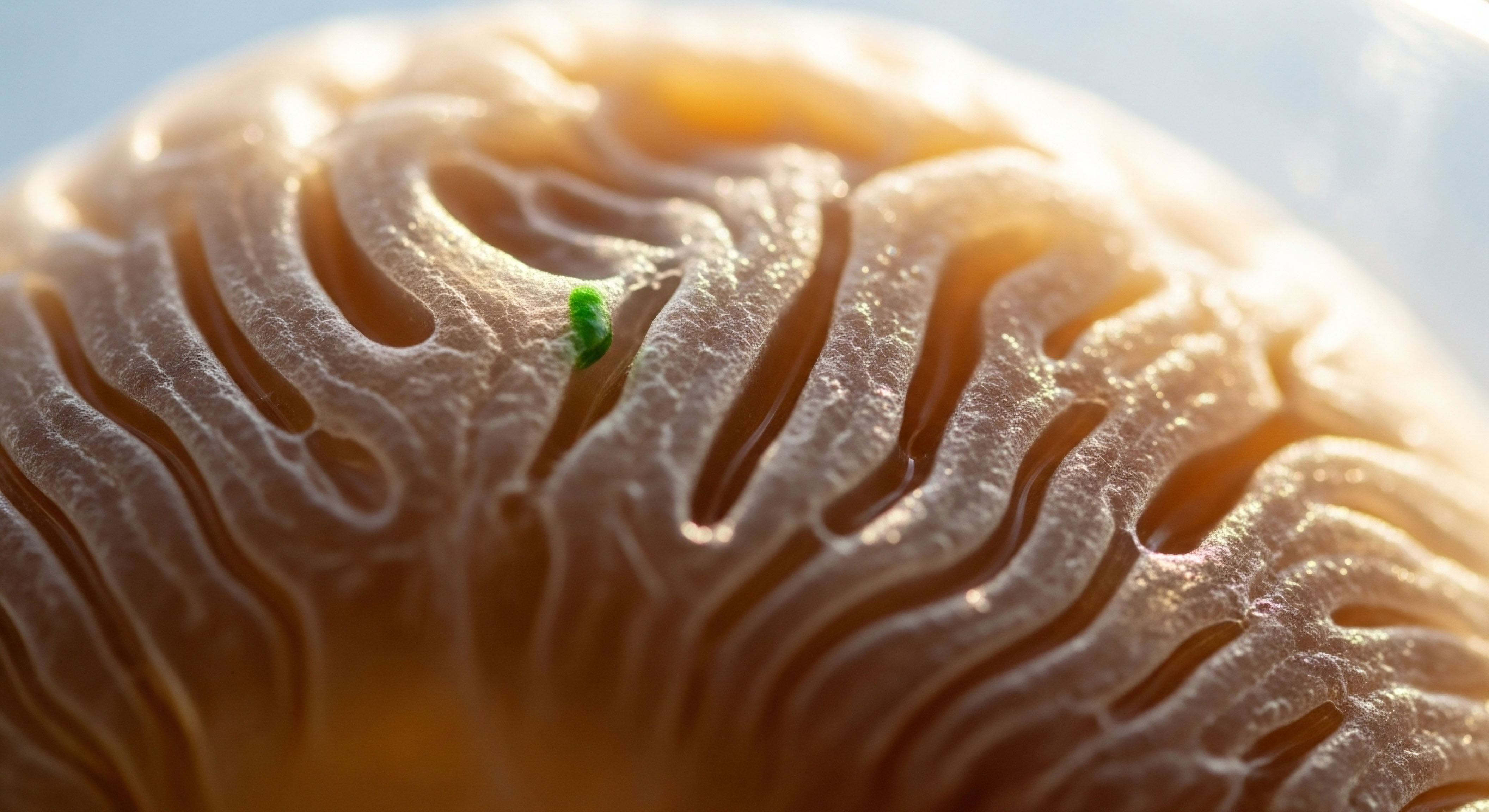

Fundamentals
Experiencing shifts in your body’s internal rhythms can feel disorienting, particularly when those changes touch upon something as fundamental as reproductive capacity. Many individuals who have pursued hormonal optimization protocols, such as testosterone replacement therapy, discover a renewed sense of vitality and well-being.
Yet, a common, deeply personal concern arises when considering the future ∞ the potential impact on fertility. This concern is valid, reflecting a natural desire to maintain all aspects of one’s biological potential. Understanding the intricate systems governing male reproductive health offers a pathway to reclaiming that potential, even after exogenous hormonal interventions.
The body operates through sophisticated communication networks, and the hypothalamic-pituitary-gonadal axis, often called the HPG axis, stands as a central command center for male reproductive function. This axis involves a precise dialogue between three key endocrine glands. The hypothalamus, located in the brain, initiates the conversation by releasing gonadotropin-releasing hormone, or GnRH. This signaling molecule travels to the pituitary gland, a small structure situated at the base of the brain.
Upon receiving GnRH, the pituitary gland responds by secreting two crucial gonadotropins ∞ luteinizing hormone (LH) and follicle-stimulating hormone (FSH). LH then travels through the bloodstream to the testes, where it stimulates the Leydig cells to produce endogenous testosterone. Simultaneously, FSH acts on the Sertoli cells within the testes, which are essential for supporting and nourishing developing sperm cells, a process known as spermatogenesis. This coordinated effort ensures the continuous production of both testosterone and sperm, maintaining male reproductive health.
Testosterone replacement therapy can suppress the body’s natural reproductive signaling, impacting fertility.
When exogenous testosterone is introduced into the system, as occurs with testosterone replacement therapy, the body’s internal feedback mechanisms detect elevated testosterone levels. This signals the hypothalamus and pituitary gland to reduce their own output of GnRH, LH, and FSH.
This suppression, a natural regulatory response, leads to a significant decrease in the testes’ endogenous testosterone production and, critically, a reduction or cessation of sperm production. For individuals seeking to restore fertility after discontinuing such therapy, the primary challenge involves reactivating this suppressed HPG axis and encouraging the testes to resume their natural functions.
The journey toward restoring reproductive capacity involves a thoughtful approach to biochemical recalibration. It requires a deep appreciation for the body’s inherent ability to adapt and respond when provided with the correct signals. This process is not about forcing a system, but rather about gently guiding it back to its optimal, self-regulating state.


Intermediate
For individuals who have paused testosterone replacement therapy with the aim of restoring fertility, specific clinical protocols are employed to reawaken the dormant HPG axis. These interventions are designed to mimic or stimulate the natural hormonal signals that drive sperm production. The goal involves encouraging the body to resume its intrinsic production of gonadotropins and testicular hormones, thereby reactivating spermatogenesis.

Targeted Endocrine Recalibration Protocols
A multi-pronged strategy often guides the process of fertility restoration. This approach typically involves agents that directly or indirectly stimulate the HPG axis. The selection of specific medications and their dosages is highly individualized, based on a patient’s unique hormonal profile, the duration of prior testosterone therapy, and their overall health status.
- Gonadorelin ∞ This synthetic analog of GnRH acts directly on the pituitary gland, prompting it to release LH and FSH. Administered via subcutaneous injections, often twice weekly, Gonadorelin provides a pulsatile stimulation similar to the body’s natural GnRH release, which is essential for effective pituitary response. This direct stimulation helps to bypass the hypothalamic suppression induced by exogenous testosterone, signaling the pituitary to resume its critical role in the reproductive cascade.
- Tamoxifen ∞ As a selective estrogen receptor modulator, Tamoxifen works by blocking estrogen’s negative feedback on the hypothalamus and pituitary. Estrogen, even in men, can suppress GnRH, LH, and FSH release. By inhibiting estrogen’s action at these receptor sites, Tamoxifen effectively “tricks” the brain into perceiving lower estrogen levels, thereby increasing the output of GnRH, LH, and FSH. This leads to a subsequent rise in endogenous testosterone and, indirectly, supports spermatogenesis.
- Clomid ∞ Similar to Tamoxifen, Clomid (clomiphene citrate) is another selective estrogen receptor modulator. It functions by competitively binding to estrogen receptors in the hypothalamus and pituitary. This action prevents estrogen from exerting its inhibitory effects, resulting in an increased secretion of GnRH, LH, and FSH. Clomid is a well-tolerated oral medication, often prescribed daily or every other day, to stimulate the testes to produce more testosterone and sperm.
- Anastrozole ∞ This medication is an aromatase inhibitor. Aromatase is an enzyme that converts testosterone into estrogen. While some estrogen is necessary for male health, excessive levels can suppress the HPG axis. Anastrozole reduces the conversion of testosterone to estrogen, thereby lowering circulating estrogen levels. This reduction in estrogen can alleviate its negative feedback on the pituitary, allowing for increased LH and FSH secretion and supporting endogenous testosterone production. It is typically used when estrogen levels are elevated, contributing to HPG axis suppression.
Reactivating the HPG axis after testosterone therapy requires specific medications to stimulate natural hormone production.
The duration of these protocols varies considerably. Some individuals may see a return of sperm production within a few months, while others might require a year or more. Factors influencing recovery include the length of time on testosterone therapy, the dosage used, and individual biological responsiveness.

How Do Peptides Support Overall Well-Being during This Process?
While the direct restoration of fertility post-TRT primarily involves the agents mentioned above, peptide therapy can play a supportive role in optimizing overall physiological function, which indirectly contributes to a healthier reproductive environment. Peptides are short chains of amino acids that act as signaling molecules within the body, influencing various biological processes.
Certain peptides, particularly growth hormone secretagogues, can enhance systemic health. These include:
| Peptide Name | Primary Mechanism of Action | Relevant Systemic Benefits |
|---|---|---|
| Sermorelin | Stimulates natural growth hormone (GH) release from the pituitary gland. | Improved body composition, enhanced recovery, better sleep quality, increased vitality. |
| Ipamorelin / CJC-1295 | Potent GH secretagogues, promoting sustained GH release. | Muscle mass support, fat reduction, improved skin elasticity, enhanced cellular repair. |
| Tesamorelin | A GHRH analog, specifically targets visceral fat reduction. | Metabolic health improvement, reduced abdominal fat, potential cardiovascular benefits. |
| Hexarelin | GH secretagogue with potential for muscle growth and injury recovery. | Supports tissue repair, anti-inflammatory effects, potential for lean mass. |
| MK-677 | Oral GH secretagogue, increases GH and IGF-1 levels. | Bone density support, improved sleep, skin health, muscle mass. |
Beyond growth hormone secretagogues, other targeted peptides offer benefits that can complement a fertility restoration journey. For instance, PT-141 (Bremelanotide) addresses sexual health by acting on melanocortin receptors in the brain, potentially improving libido and sexual function, which can be a concern for some individuals during hormonal recalibration.
Additionally, Pentadeca Arginate (PDA) is recognized for its roles in tissue repair, healing processes, and inflammation modulation. A body functioning optimally, with reduced inflammation and efficient cellular repair, provides a more conducive environment for all physiological processes, including those governing reproduction.

Does Peptide Therapy Directly Influence Sperm Production?
While growth hormone peptides primarily impact overall metabolic health, body composition, and recovery, their influence on the reproductive system is largely indirect. A healthier metabolic state, improved sleep, and reduced systemic inflammation can create a more favorable environment for the HPG axis to recover and function optimally.
Some research indicates that growth factors, including IGF-1 (which is influenced by GH), play roles in testicular function and sperm vitality. However, direct clinical evidence demonstrating growth hormone peptides as primary agents for restoring spermatogenesis after TRT discontinuation remains limited. Their value lies in supporting the body’s broader physiological resilience during a period of significant endocrine adjustment.


Academic
The cessation of exogenous testosterone replacement therapy initiates a complex physiological cascade aimed at restoring endogenous reproductive function. This process hinges on the re-establishment of the delicate feedback loops within the hypothalamic-pituitary-gonadal axis. Understanding the molecular and cellular underpinnings of this recovery is paramount for effective clinical management.

Endocrine System Recalibration after Exogenous Testosterone
Exogenous testosterone, by providing supraphysiological levels of androgens, exerts a potent negative feedback on the hypothalamus, suppressing the pulsatile release of gonadotropin-releasing hormone (GnRH). This, in turn, leads to a significant reduction in the pituitary’s secretion of luteinizing hormone (LH) and follicle-stimulating hormone (FSH). The diminished LH stimulation results in Leydig cell atrophy and a marked decrease in intratesticular testosterone production, which is critically required for spermatogenesis. Reduced FSH signaling impairs Sertoli cell function, further compromising sperm development.
The primary objective of post-TRT fertility restoration protocols involves stimulating the HPG axis to overcome this suppression. Pharmacological agents are selected based on their specific targets within this axis:
- GnRH Agonists/Analogs (e.g. Gonadorelin) ∞ Administering GnRH in a pulsatile fashion directly stimulates the pituitary gonadotrophs to synthesize and release LH and FSH. This bypasses the hypothalamic suppression, providing the necessary signals to the testes. The pulsatile nature of GnRH release is crucial; continuous administration would paradoxically desensitize the pituitary, leading to further suppression.
- Selective Estrogen Receptor Modulators (SERMs) (e.g. Clomiphene Citrate, Tamoxifen) ∞ These compounds act as competitive antagonists at estrogen receptors in the hypothalamus and pituitary. By blocking estrogen’s negative feedback, they increase GnRH pulse frequency and amplitude, consequently elevating LH and FSH secretion. This leads to a rise in endogenous testosterone and intratesticular testosterone, which are essential for initiating and maintaining spermatogenesis. Clinical data indicate that Clomiphene Citrate can significantly increase serum testosterone and improve sperm concentration in men with secondary hypogonadism.
- Aromatase Inhibitors (AIs) (e.g. Anastrozole) ∞ AIs inhibit the enzyme aromatase, which converts androgens into estrogens. By reducing estrogen levels, AIs diminish estrogenic negative feedback on the HPG axis, thereby increasing LH and FSH secretion. This mechanism is particularly relevant in men with elevated estrogen levels, which can contribute to hypogonadism and impaired spermatogenesis. Studies have shown Anastrozole can increase serum testosterone and improve sperm parameters in infertile men with low testosterone.
Reactivating the HPG axis after testosterone therapy involves precise pharmacological interventions to stimulate natural hormone production.

The Interplay of Growth Factors and Reproductive Function
While the direct pharmacological interventions focus on the HPG axis, the broader physiological environment significantly influences the success of fertility restoration. This is where the role of various growth factors and peptides becomes relevant, albeit often indirectly. The insulin-like growth factor-1 (IGF-1) system, for example, plays a role in testicular function. IGF-1 is expressed in Sertoli cells and contributes to germ cell development and sperm maturation. Lower levels of IGF-1 in seminal plasma have been associated with male infertility.
Growth hormone secretagogues, such as Sermorelin, Ipamorelin, and CJC-1295, stimulate the endogenous release of growth hormone (GH) from the pituitary. GH, in turn, stimulates the liver to produce IGF-1. By optimizing GH and IGF-1 levels, these peptides can support overall cellular health, metabolic function, and tissue repair. While not directly stimulating spermatogenesis in the same manner as gonadotropins, a healthier systemic environment, characterized by improved metabolic parameters and reduced inflammation, provides a more fertile ground for the recovering reproductive axis.
| Factor | Impact on Recovery | Clinical Implication |
|---|---|---|
| Duration of TRT | Longer duration often correlates with prolonged recovery time. | Counseling should include realistic timelines for fertility return. |
| TRT Dosage | Higher doses can lead to more profound HPG axis suppression. | May necessitate more aggressive or prolonged stimulation protocols. |
| Patient Age | Younger men generally exhibit greater hormonal resilience. | Age is a significant predictor of recovery success and speed. |
| Baseline Fertility Status | Pre-existing subfertility can complicate recovery. | Comprehensive baseline fertility assessment is crucial. |

What Are the Long-Term Implications of Hormonal Recalibration?
The process of restoring fertility after TRT discontinuation extends beyond simply achieving sperm production. It involves a holistic recalibration of the endocrine system, impacting metabolic health, bone density, and psychological well-being. The sustained suppression of the HPG axis can have broader systemic consequences, and the recovery process aims to mitigate these. For instance, the restoration of endogenous testosterone production, facilitated by LH and FSH stimulation, supports not only spermatogenesis but also bone mineral density, muscle mass, and cognitive function.
The judicious application of peptides, particularly those influencing growth hormone, can further support this systemic recovery. By enhancing cellular repair mechanisms, improving body composition, and supporting metabolic efficiency, these peptides contribute to a more robust physiological state. This comprehensive approach acknowledges that reproductive health is inextricably linked to overall systemic vitality. The goal remains to guide the body back to a state of self-regulation, where its inherent biological intelligence can operate without compromise.

How Do Individual Responses Vary to Fertility Restoration Protocols?
Individual biological variability means that responses to fertility restoration protocols can differ significantly. Genetic predispositions, the underlying cause of initial hypogonadism, and the body’s unique capacity for endocrine recovery all play roles. Some individuals may experience a rapid return of spermatogenesis, while others might require extended periods of treatment or a combination of therapies.
This variability underscores the importance of personalized treatment plans, guided by regular hormonal assays and semen analyses, to adapt protocols as needed. The journey is often iterative, requiring patience and close collaboration with clinical professionals.

References
- Crosnoe, L. E. Exogenous testosterone ∞ a preventable cause of male infertility. Translational Andrology and Urology, 2(3), 137 ∞ 143. 2013.
- El Meliegy, A. Motawi, A. & Abd El Salam, M. A. Systematic review of hormone replacement therapy in the infertile man. Arab Journal of Urology, 16(1), 1 ∞ 8. 2017.
- Shoskes, D. A. & Lipshultz, L. I. Male Fertility and Testosterone Therapy (Chapter 34). In Men’s Reproductive and Sexual Health Throughout the Lifespan ∞ An Integrated Approach to Fertility, Sexual Function, and Vitality, pp. 269-278. Cambridge University Press. 2023.
- Wenkler, B. et al. Age and Duration of Testosterone Therapy Predict Time to Return of Sperm Count after hCG Therapy. Journal of Urology, 199(4), e676-e677. 2018.
- Traish, A. M. Testosterone and the aging male ∞ a perspective. Journal of Andrology, 35(6), 801-807. 2014.
- Karakas, M. et al. NGF, EPO, and IGF-1 in the Male Reproductive System. International Journal of Molecular Sciences, 24(16), 12906. 2023.
- Sigalos, J. T. & Pastuszak, A. W. The Safety and Efficacy of Clomiphene Citrate and Testosterone Therapy in Men. Current Sexual Health Reports, 8(2), 101-108. 2016.
- Yassin, A. A. & Saad, F. Testosterone and Male Fertility. Andrology, 1(4), 548-557. 2013.

Reflection
Your personal health journey is a unique exploration, marked by individual biological responses and evolving aspirations. The knowledge shared here about hormonal systems and therapeutic pathways serves as a compass, guiding you toward a deeper understanding of your own physiology.
Recognizing the interconnectedness of your endocrine system with overall vitality allows for a more informed and empowered approach to well-being. This information represents a starting point, a foundation upon which to build a personalized strategy for reclaiming your biological potential. True vitality arises from understanding your body’s signals and working in harmony with its innate intelligence.



